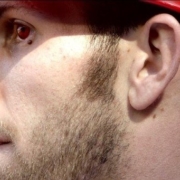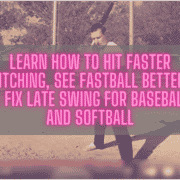Improve sports vision training when hitting, keep eye on the baseball, and learn how to see softball better. Discover the North Virginia Doctors of Optometry, Falls Church apps, glasses, and drills training.
Baseball Vision Training That Bryce Harper Is Talking About

Check out Bryce Harper’s amber tinted lenses that help with the sun and different hitting backgrounds in the 2012 playoffs. Photo courtesy WashingtonPost.com
I have the honor and privilege of introducing baseball vision training expert Dr. Keith Smithson to you.
What does he do? I HIGHLY recommend CLICKING HERE for a piece the Washington Post did about his baseball vision training, titled, “Washington Nationals Go Beyond The Eye Chart With Vision Training”.
In a nutshell, Dr. Keith helps his hitting athletes try and ‘buy time’. By the way, his baseball vision training works for fastpitch softball as well! His background? Dr. Keith Smithson is the:
- Director of Visual Performance for the Washington Nationals,
- Team Optometrist for the Washington Wizards, Washington Mystics, Washington Spirit and DC United, and
- Visual Performance Consultant for the Washington Redskins, Washington Capitals and Nike.
He’s also graciously contributed more BONUS baseball vision training videos that I’m including in my Reaction Time Mastery online video course that will help hitters track pitches crystal clear, accelerate decision-making reaction time, & get ON-TIME without losing swing effectiveness.
SCIENCE-BASED TRAINING:
Improve your hitting strategy dramatically by applying human movement principles.
Learn not only how and what to train but also the science behind the methods.
You’ll find nothing like this course in the hitting industry.
Dr. Smithson has also agreed to share new technologies and strategies with HPL in the future, so you guys and gals will truly be on the cutting edge of vision and tracking!
The Doc is a very busy guy, but he agreed to answer a couple interview questions, so without further adieu,
Enter Dr. Keith Smithson…
If you were to train me for four weeks for a HUGE tournament and had a million dollars on the line, what would the baseball vision training look like? What if I trained for eight weeks?
I would begin with a comprehensive visual performance enhancement using the latest dynamic vision testing technology such as the RightEye system.
Based on objectively quantifiable test scores, we would begin a protocol of in-office and home based visual performance enhancement.
We would discuss visual acuity and contrast enhancement using corrective lenses and nutritional supplementation. We would maximize eye muscle function, as well as neurological visual processing function and achieve results, as current studies predict.
What makes you different? Who trained you or influenced you?
VIERA, FL February 15 : Dr. Keith Smithson, sports vision specialist. works with Washington Nationals second baseman Steve Lombardozzi (1) on his vision skills where they would toss a ring and call out a color and they would attempt to catch the color during spring training workouts on February 15, 2013 in Viera, FL (Photo by Jonathan Newton / The Washington Post)
All of my testing and training methods are scientifically driven. I use objectively quantifiable testing and training tools to establish performance baselines before training and follow those results throughout training to target the training program and customize each program per the individual athlete’s needs.
I also work with multiple different professional sports teams, therefore I gain a vast understanding of the complex and differing needs of these athletes specific to their sport and position in that sport. I truly learn as much from them, as I trust they learn from me.
What are the biggest mistakes and myths you see in hitting? What are the biggest wastes of time?
By in large baseball players are the most passionate about understanding the visual needs of their sport and are the most open to emerging technologies to maximize their visual potential.
The biggest misconception is that eye dominance plays an important role in visual performance in baseball. A study was done several years ago that showed equal hitting performance for same sided and cross dominant athletes.
It is far more important to have equal visual ability and a coordinated eye muscle system to ensure proper eye tracking and depth perception judgements.
Dr. Keith Smithson can be found at: www.novaeyedocs.com
Also, as per Dr. Smithson’s recommendation, sports vision doctors can be found using the doctor locator on aoa.org.

























